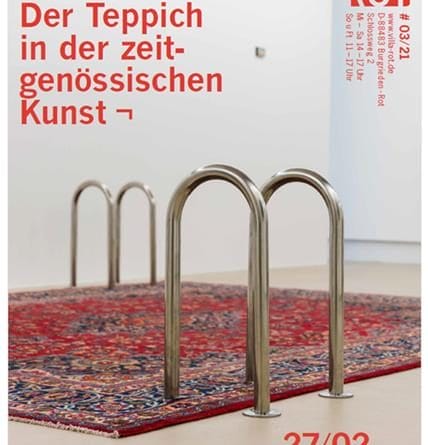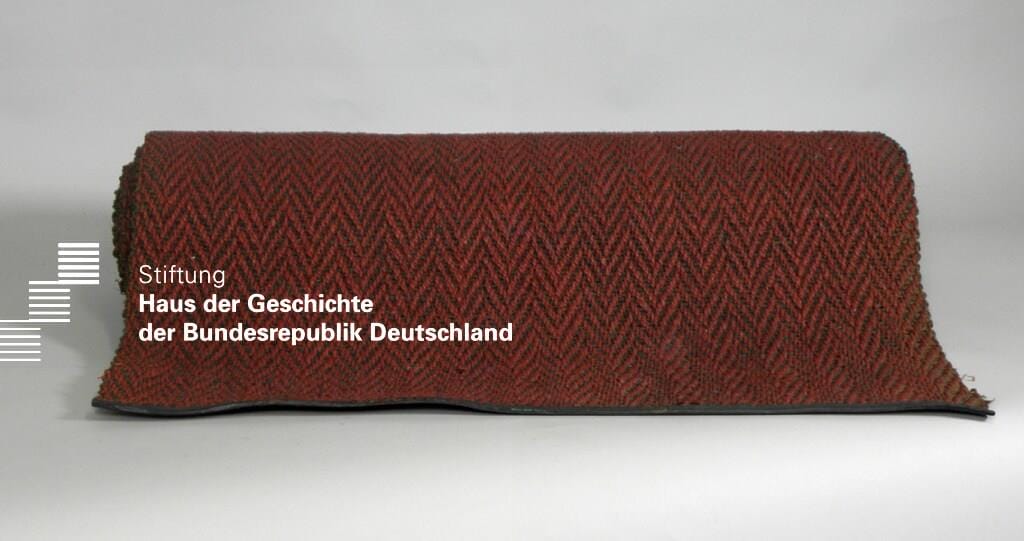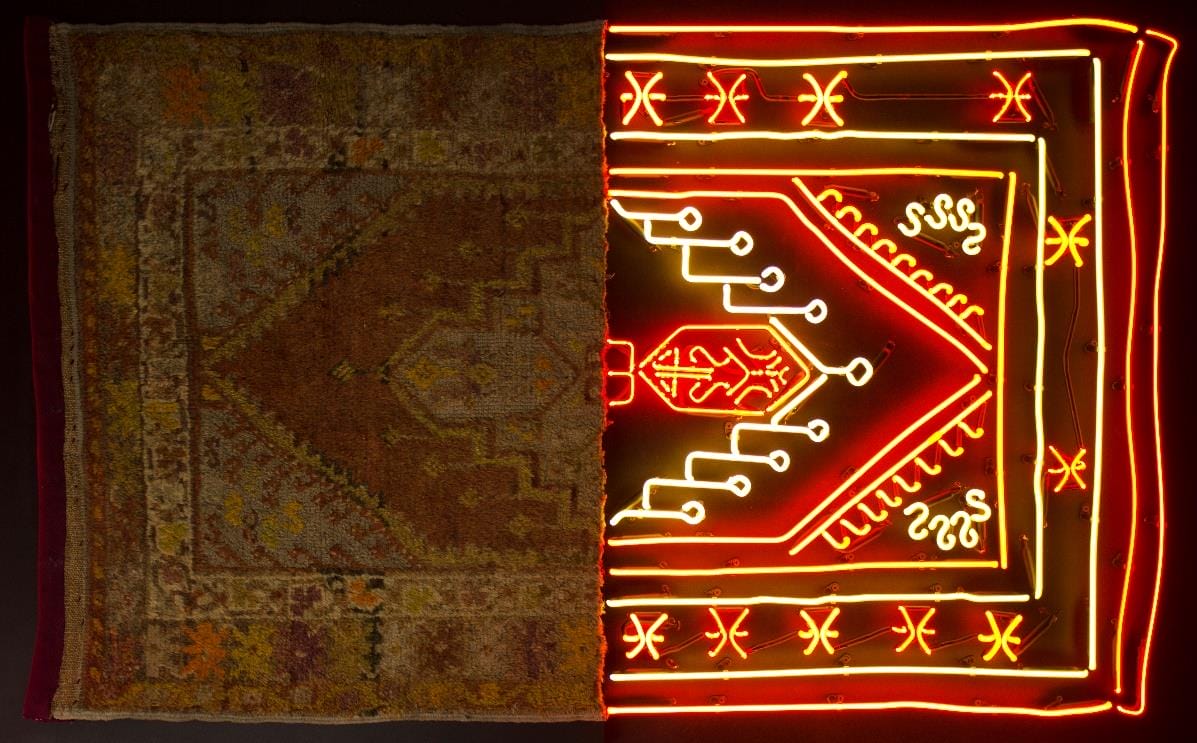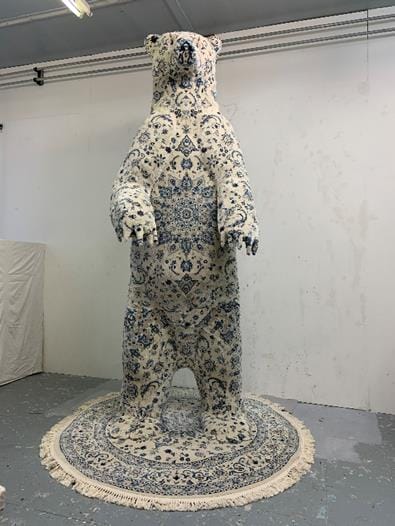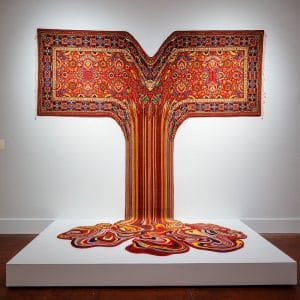SEEING WITH YOUR FEET – THE CARPET IN CONTEMPORARY ART
February 27 – May 22, 2022
Museo Villa Rot
Schlossweg 2 – 88483 Burgrieden – Rot
T : +49 (0) 73 92 / 83 35 – F : +49 (0) 73 92 / 1 71 90
info@villa-rot.de
They come in all imaginable shapes, colors and variations: high pile, Persian, fur, oriental, woven, hand-knotted or machine-made. The oldest known example of a knotted carpet is the Pasyryk carpet. It was probably made around 500 BC in Western Asia and was recovered from a grave preserved in permafrost in the Pasyryk Valley in the Altai Mountains (southern Siberia). Carpets not only exist in an immense variety, but obviously have existed for a very long time. Their history is always linked to the history of man; for example, they say something about his sedentariness, his relationship to space, or even about his hospitality.
Rolling out the red carpet
Even though the exhibition primarily wants to highlight the contemporary interpretation of this traditional medium, it also shows historical carpets. In addition to objects from the museum’s own collection, we will present, for example, the red carpet that used to be rolled out for important state guests of the Federal Republic of Germany between 1958 and 1968. The ceremony was considered to be a sign of reverence symbolizing hospitality towards visitors from abroad. The object on display at Villa Rot is the centerpiece of the red carpet that was rolled out to welcome state guests at Cologne-Bonn Airport in those days. We may therefore almost certainly assume that Charles de Gaulle, Dwight D. Eisenhower, John F. Kennedy, Queen Elizabeth II and many other famous personalities have walked across it.
Carpets – between tradition and modernity
One object that bridges the gap between the past and the present in a special way is Ramazan Can’s work „To feel at home – Evinde Hessetmek“. He divides his carpet exactly in the middle presenting one half in the impression of a classical Persian carpet, the other half as neon lighting. This makes the work a shining example of overcoming opposite positions combining tradition with modernity.
Animalistic carpet art
One of the eye-catchers of the exhibition is undoubtedly Debbie Lawson’s fantastic animal creations. For example, at the start of the exhibition, visitors are given a bear that is over 2.40 metres tall and has exchanged its fur for a “Persian” rug. The stag’s antlers, which will be on display at this point, also show how exotic artists are currently dealing with the medium of carpet.
From the floor to the wall – and back again
Apart from the design and motifs of carpets, their positions in the room are also extremely interesting. Whether for decoration or for pragmatic reasons, we find carpets mostly on our floors. The tapestries of past centuries, however, were mostly bound to wall surfaces – think of the magnificent tapestries of the Middle Ages and the early modern period. Today, carpets (also and especially in an artistic context) can be found everywhere in the room – whether in the impression of the flying carpet on the ceiling, as a narrative medium on the wall or quite classically on the floor. In addition, there are also carpets that seem unable to make up their minds – their positions and motifs wander through the room, as it were, and appear as if in flux. The medium of carpet remains fluid, just like the needs that people place on it.
Participating Artists and Institutions:
ABK Stuttgart, Debbie Lawson, Littlewhitehead, Salah Saouli, Stiftung Haus der Geschichte
der Bundesrepublik Deutschland, Slavs and Tatars, Zuzanna Czebatul, Ramazan Can, Farkhondeh Shahroudi, Pia Ferm, Noémi Kiss, Faig Ahmed
Museum Villa Rot
As an exhibition house for contemporary art, the Museum Villa Rot has become a beacon in the region in recent years. Progressive exhibition formats and exciting thematic exhibitions not only delight the public, but also the press, sponsors and the professional public.
Mission Statement
We believe that art and culture are indispensable for a free and enlightened society. For this reason, we have set ourselves the goal of presenting and communicating current trends and positions within international contemporary art to as broad an audience as possible. Through a diverse spectrum of group, solo and thematic exhibitions as well as multimedia mediation formats, we offer visitors of all ages opportunities for individual access to contemporary art. Our vision is to encourage our audience to critically examine the issues of our time, to give them pleasure in a creative approach to art, and to whet their appetite for the unbiased, aesthetic enjoyment of art.
The residential ambience and the intimate rooms of the museum favor proximity to the public and create a charming setting for contemporary art exhibitions. With the Kunsthalle, the Museum Villa Rot received a contemporary, award-winning extension in 2014, which fits ideally into the park landscape, opens up new perspectives and significantly expands the exhibition space. The legal entity of the Museum Villa Rot is the non-profit, civil-law Hoenes Foundation.
